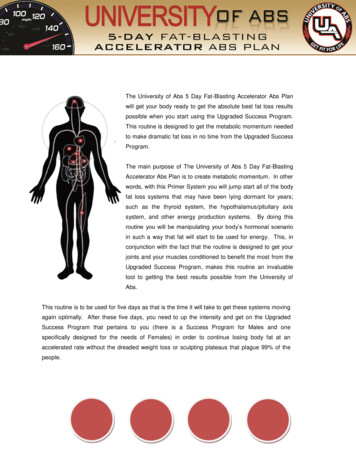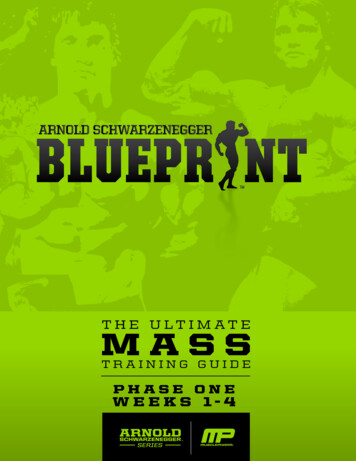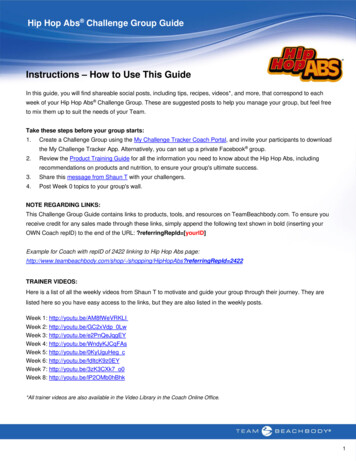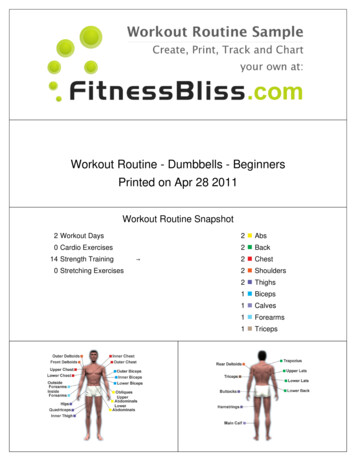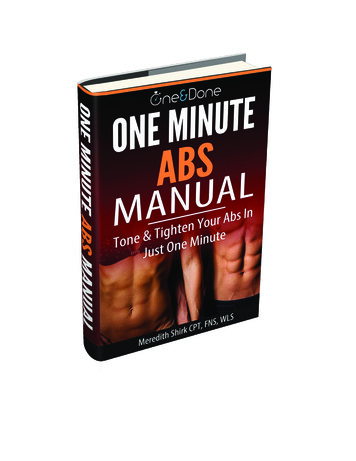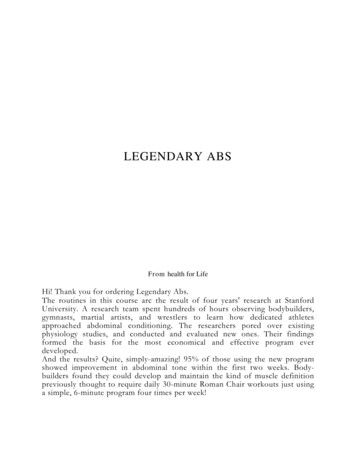
Transcription
LEGENDARY ABSFrom health for LifeHi! Thank you for ordering Legendary Abs.The routines in this course arc the result of four years' research at StanfordUniversity. A research team spent hundreds of hours observing bodybuilders,gymnasts, martial artists, and wrestlers to learn how dedicated athletesapproached abdominal conditioning. The researchers pored over existingphysiology studies, and conducted and evaluated new ones. Their findingsformed the basis for the most economical and effective program everdeveloped.And the results? Quite, simply-amazing! 95% of those using the new programshowed improvement in abdominal tone within the first two weeks. Bodybuilders found they could develop and maintain the kind of muscle definitionpreviously thought to require daily 30-minute Roman Chair workouts just usinga simple, 6-minute program four times per week!
Now you will discover how well it works. You'll feel it, too. From the very firstworkout, Legendary Abs will make your abs burn just as much as a good bicepworkout makes your biceps burn!Because of your interest in conditioning and exercise, you probably know moreabout the subject than most people. You may even be doing some of theexercises in this course. Please note: The research behind the program wasaimed not only at determining which ab exercises are most effective, but moreimportantly, at discovering the optimum way to combine them. This isSynergism-creating a whole greater than the sum of tile parts. Tile individualexercises described in Legendary Abs become many times more effective whenused exactly as indicated. It is the specific per-level sequence, timing, andoverall progression that make our program such a powerful conditioning tool.It's interesting how far off the mark traditional training advice falls. Did youknow, for example, that tile straight-legged sit-up is not an efficient abdominalexercise? And that it's actually bad for you?But we're getting ahead of ourselves. To explain this clearly, we must trace thecourse of our research through some areas of kinesiology and physiology, to theconclusions that shaped this unique program.I N T H E B E GI N N I N G, THERE WAS MUSCLE.(Later, unfortunately, came fat).Muscle is the powerhouse of the body. (It has a very special characteristic: itcontracts. Given stimulus by the central nervous system, muscle fibers shorten to abouttwo-thirds of their original length. And because of the clever ways in which those fibersare positioned, humans can do amazing things: like run 4-minute miles, climbimpossibly high mountains, and make quick recoveries when they trip over their ownshadows in public.Muscles also protect your body from injury. The abdominals in particular, runningfrom the bottom of the rib cage to the top of the pelvis, shield the delicate internalorgans.Finally, the abdominals are essential to good posture. They act in concert with theSpinal Erectors to hold you and your spine upright, much the same way opposing guywires support a tent pole.At least, that's what they were designed to do.Soft, out of shape abdominals do little supporting or protecting. They don't lookgreat, either-hence the many diet and exercise programs available today. Theseprograms, however, usually fail to distinguish between toning abdominal muscle andgetting rid of excess fat.
Muscle and fat lay next to each Other in the b o d y , b u t t h e y arc distinct and separatelayers.Fat is the body's way of storing 'extra' fo o d . You eat more than you need to sustainyour daily activity; tile excess ends up on your thighs, or the backs of your arms, andaround your middle in the form of enlarged fat cells.Getting rid of unwanted fat, if that is you goal, simply requires you to observe thetried and-true formula:DIET EXERCISE WEIGHT LOSSNo secret here. Doing muscular work require energy. That energy is derived from thefood you eat and from your fat stores. If you decrease food intake and/or increaseenergy output, yet lose fat. Simple.Some people, though, mistakenly assume the can 'burn' Eat from around their middlesby doing exercises involving the muscles in that area--s ups, side bends, and the like.Not so. Doing exercises for any single muscle group does burn enough calories tonoticeably reduce fat Furthermore, when fat does comes off, it comes off evenly fromall over the body-not just the area being worked. To get rid of Eat, y must force yourbody as z whole to burn lots calories by involving as many major muscle groups aspossible. This means doing exercises like running, swimming, cycling, aerobic dance orjumping rope, and doing them consistently over a period of time. So much for fat. Tocondition abdominal muscle, it's necessary to do exercises that. Involve the abs, Overload the abs-forcing them to do more work than they're used to, Work the abs from a variety of different angles so that all the muscle fibersget a workout.
Withthis in mind, let's take a look at tile most common abdominal exercises.THE GOOD WORD ON SIT-UPSDon't Do Them!At first thought, straight-legged sit-ups or Roman Chair sit-ups seem reasonablecandidates for an abdominal toning program. The stomach muscles appear to be in themiddle of the crunch that occurs when you sit up, and they "burn" during the course ofthe exercises. So they must be doing the work, right? 'Actually, no. It's true the abdominals contract when you do these exercises. But theabs have a. much narrower range of motion than these exercises require If you tie Raton your back with legs extended, your abs have the capacity to raise your shouldersabout 30 off the floor. No further any motion above and beyond that is not the work ofthe abs. Since the ; Straight Legged Sit-Up calls for about 90 of trunk flexion, twothirds of the motion is wasted on other muscles.As for the Roman Chair Sit-Up, except for getting into position, the movementdoesn't call the abs into play at *all! The most you get out of rocking back and forth is abit of thickening of abs muscle tissue at tile point where it joins the rib cage. As withStraight-Legged Sit-Ups, other muscles do all the real work.These "other muscles," the Psoas Magnus and Psoas Parvus, run Erocn the front oftile legs up through the pelvis, connecting to the lowest six spinal vertebrae. They p u l lyour trunk toward your legs, as do your abs. but unlike the abs, their range of motion ishuge: they can pull you forward all the way from a full backbend until your chesttouches your knees.Unfortunately while psoas do their job of raising your torso most efficiently whenyour legs are extended and/or your feet are held--as in Straight-Legged Sit-Up postureand Roman Chair posture. When you start an exercise in this position, the psoascompete with your abs for the first third of the movement, and then take over entirelyfor the remaining two-thirds.This makes a strong case of inefficiency against the two old favorites.Besides their inefficiency, though, the real problem with these exercises is the stressthey put on your lower back. With each straight legged contraction, the psoas tug at the
place where they connect to the spine. That tug doesn’t do much damage as long as yourabs remain strong enough to prevent your back from arching. But the abs tire fairlyquickly even when you're in great shape, and then you do arch. This allows thevertebrae immediately a b o v e a n d b e l o w the psoas insertion to grind together, and in adecade or so you may be stuck with permanent lower back pain as a result of diskdegeneration.Every kineseology text we have ever seer warns against any supposed abdominalecercise where both:1. The psoas come into play,2. your position allows---or worse, encourages your back to arch during the courseof the exercise.Based on these criteria, we can eliminate these and other similar exercises fromour program the Roman Chair Sit-Up, for its inefficiency, and the Straight-LeggedSit-Up for its damaging, effect on the spine. Fortunately, there are exercises that fitour needs perfectly; these -, will be explained in the program Section of this course.Some may be familiar to you, Just remember-there's much more to this kind ofapproach than the exercises themselves.SYNERGISM:The Critical ElementResearch has demonstrated there is one particular sequence of a given series ofexercises that affords maximum benefit to all the muscles involved. That sequencemakes each of the exercises more effective than those very same exercises performedindividually. This is Synergism: combining elements to create a whole greater than amere sum of the parts.The ideal order of a series of exercises is partly defined by a principle called "TileInterdependency Of Muscle Groups". Let us explain it this way:Imagine the stomach muscles divided into upper abs and lower abs. The line isusually drawn between the top two and bottom two abdominal lumps. This isn't atechnical division, and you won't find it listed in G r a y ’ s Anatomy, but for the sake ofour discussion it exists nonetheless.The upper abs can in turn be divided into center and outer sections. From now on, wecan use the term "upper abs" to refer to the center section; the outers we will call bytheir actual name: the External Obliqucs.First consider just the upper (center) abs the 'lower abs. They arc interdependent inthis way:To work the lower abs, you necd to use LOWER ABS AND UPPER ABS.To work the upper abs, you only need use UPPER ABS.Notice the upper abs play a role in the work you do for both areas. As a result, if youtire the upper abs first, their fatigue will limit amount of lower work you can do. Thesolution, exercise the lower abs first. That way you’ll exhaust the lowers completely,and then the uppers to their limit with exercises that concentrate on them.
A side benefit of this approach is that the upper abs, once tired from lower abexercises don't have to be pushed as hard to get a workout.Bringing the obliqucs into the picture, will make a similar argument for twisting(cross knee) versus straight ab exercises. Twin movements involve both the obliques anupper ribs. Straight movements primarily in the upper abs. If you do straight moverfirst, the upper abs get tired, preventing from you pushing the obliques to their limitstwisting exercises should precede straight forward exercises.At this point we have the three rules needed to begin putting together a synergisticabdominal conditioning routine:RULE 1. Avoid exercises that activate the psoas muscles and require a bodyposition that allows the back to arch.EFFECT: We eliminate many "standard" ab exercises, straight-legged sit-ups,Roman chair sit-ups, incline board sit-ups, bent-legged, and feet-under-a-couch sit-upRULE 2. Work lower abs before upper abs.RULE 3. Do twisting (oblique) upper abs exercises before straight upper absmotions.EFFECT: We sort the remaining suitable exercises into general categoriesreflecting the order in which they should be performed. First: exercises mainlyinvolving lower abs; Second: exercises involving twisting movements; . Third:exercises mainly involving upper abs.EFFECT:Remember, synergism means finding a way to exercise so each bit of work you doreinforces all -our other work. The most effective specific order within the categoriesmust be determined by experimentation and a bit of physiological detective work. Ourresearchers have done this or you; their findings shaped the routines described in theProgram Section.The Legendary Abs routines will take you as close as you wish to the ancient Greeksculpto r s idea of a well defined mid-section. The total amount of time you will spend onany particular day will never exceed six minutes.The time it will take to reach your goal depends on your present physical conditionand the consistency with which you train. It won't be long, though. 1f you don't havemuch extra fat, you should see results within a couple of weeks. Mild soreness shouldconic after the first or second workout (a definite indication that something ishappening!).
PROGRAM SECTIONThe ExercisesLook over these exercises to become familiar with them. Following the exercisedescriptions, we'll present a series of routines ranging from beginning to very advanced.Again, don't be surprised if some of the exercises are similar to exercises you've done inthe past. Remember, it's the sequence and timing of the exercises that make all thedifference.Hanging Leg RaisesFor this particular exercise, you need a horizontal bar of any sort from which to hang;a doorway-chinning bar will work.Take a slightly wider than shoulder width grip on the bar and, keeping your uppertorso as relaxed as possible, raise your legs until your knees almost touch your chest.Your pelvis should rock forward as you raise your legs (see illustration below)--thisguarantees maximum abs involvement. Hold for a second or so, then lower legs back tothe starting position. Repeat.It's important to lower your legs just slowly enough so you don't start swinging; yourknees should be slightly bent throughout the exercise.
Hanging Knee - UpsThese are similar to the previous exercise except that in this case you should fullybend your knees as you lift, and actually try to touch them to your chest.Lying 6 –Inch Leg RaisesLie on your back on a soft mat or carpet, and place your hands under your pelvis,palms down, shown below. Raise the legs about 18 inches off the floor, then lower toabout 12 inches. Repeat--up 18, down to 12; up to 18, down to 12; etc.Y o u r h a n d s a n d arms should function as a cradle to prevent your back from arching;your 1 back should remain flat against the floor throughout the exercise.It's possible to do this one almost totally with the psoas muscles, so concentrate 'to makesure your abs that do the work. Think less of raising the-legs and more of forcing an"accordion-like" movement out of your stomach muscles-rocking the pelvis forward andback, which, in turn, should move the legs up and down.When you get it right, the abdominals will take the brunt of the strain.Note: Inevitably, you will feel this one at least to some extent in your lower back. Don'tworry it’s normal. But if the exercise actually hurts, then either (1) you are not doing 'itright (reread the description and try again), or (2) your abs are not yet strong enough to dothe exercise correctly. Wait and try again after 2 couple of weeks.
Advanced Lying 6-Inch Leg RaisesBegin Lying Leg Raises as described on previous pare. At the top of the motion,when your legs are, as far off the ground as they get, rock your pelvis up off your arms.Hold for a split second, then lower your pelvis and legs and begin your next repetition.These are more difficult than regular leg raises because the pelvic rock greatlyincreases the involvement of the abdominals. As soon as you find yourself able to dothese, substitute these wherever the routine calls for Lying Leg Raises.Abdominal CrampsLie in standard bent-knee sit-up position (sec below) and, while exhaling, veryslowly raise your shoulders and upper back about 30 off the ground. Hold for a secondor so; then slowly return starting position.Note: Keep your arms in place (palms against back of your head, elbows out) but asrelaxed as possible throughout the exercise--do not pull against the back of your head.Pulling won't make the movement any easier and it will give you one heck of aneckache.One full rep should take at least 2 seconds.
Cross-Knee Abdominal CrampsThese are a lot harder than the previous exercise, and you should save them untilregular abdominal cramps become too easy.Lie in bent-knee sit-up position, and slowly raise your shoulders, upper back, and righthip up off the ground-your right elbow should turn toward (but not touch) your leftknee. Hold at peak for at least a second; then slowly return to starting position andrepeat with left hip coming off the ground, and left elbow turning toward right knee.1/4Sit-UpsStart in bent-knee sit-up position, but with legs up off the floor so both your hipsand your knee form right angles. Quickly raise upper back and shoulders off the floor(as in Abdominal Cramps); then lower and repeat. You should do these as fast as youcan.An important difference between these and Abdominal Cramps: In this case youshould think “up” with the torso, rather than "to the knees" (as you do when doingCramps). This varies the stress on the abs and assures greater definition. Just follow thearrow in the figure below.Knee Rock-BacksThese are like inverted Abdominal Cramps. Begin in bent-knee sit-up position, feeton the floor, but arms extended straight out a few inches from your sides (palmsdown), and rock back until your knees hit your chest and your lower back comes offthe floor. Lower and repeat.Note: Pace should be moderate--about 1 rep per second.
Pull-Down Ab CrunchesDrape a towel, or something similar (like a shirt or short length of rope), aroundthe cable that connects to a lat pull-down bar so you can grab both ends of the toweland pull the bar down.The Starting Position: Kneel in front of the machine, holding onto the towel,-andbring your hands to the top of your head (this should look a bit like praying). Youshould be far enough away from the machine so that the cable comes down to you ata slight angle, rather than straight down.The Exercise: Hunch over until your elbows touch your knees, hold for a secondor so, then uncurl back to starting position. Make sure your hands stay against thc,topof your head. Repeat.Note: As you do the exercise, think of hunching over a pole running across yourchest just below your sternum. This will maximize ab involvement and minimizePsoas contribution. (see "Right' and ".Wrong" illustrations below.)
SPINAL ERECTORS: The Balancing AntagonistsEarlier in the course we mentioned that the abdominals work in concert with theSpinal Erector muscles to hold your spine upright. Throughout the body, musclegroups work in pairs to maintain a balance of strength around joints.For this reason we're including suggested work for the spinal Erectors. Thisexercise is not essential for abdominal development-we present it as part of anintegrated approach to conditioning for health. A proper balance of strength betweenthese two sets of muscles will insure good posture and a balanced distribution ofstress in daily activity.Hyper-ExtensionsThese are best done on a bench made for the purpose (you can find one in mostgyms), but can also be done on the edge of a resilient surface like a bed, padded table,arm of a sofa, etc., with someone holding your ankles.Lie face down, bent at the waist; hanging over the edge of the bench. Lightly restyour hands behind your head or neck, and slowly straighten your body to a horizontalposition. Don't come up any higher than this.Throughout the motion, keep your head and shoulders arched backwards, as in aswan dive. Don't try to lace your fingers together behind our neck; if you maintainthe proper arch, your fingers may barely touch the sides of your head.
THE ROUTINESSpeed Key(f) Fast (about 2 reps per second)(m) Medium (about 1 rep per second)(S) Slow (about 1 rep per 2 seconds)Level AIf you're new to conditioning exercise, start atthis level.)ExerciseGoal/SpeedLying 6-inch Leg Raises . 2o reps (m) o rest1/4 Sit-ups . . 25 reps (s) osecond restLying 6-inch Leg Raises . 15 reps (m) o rest1/4 Sit-ups . . 20 reps (m) o restLevel 1ExerciseLying 6-inch Leg Raises. 25 reps (m) 15seconds restLying 6-inch Leg Raises. 20 reps (m) norestAbdominal Cramps 25 reps (s) norest¼ Sit-ups 10 reps (f)Level 2ExerciseHanging Knee-ups . 10 reps (m) 15second-restHanging Knee-ups . 8 reps (m) no restAbdominal Cramps . 25 reps (s) 15second restAbdominal Cramps . 10 reps (f)Level 3ExerciseGoal/SpeedHanging Knee-ups . . 15 reps (m) 15second restHanging Knee-ups . . 10 reps (m) norestLying 6-inch Leg Raises. . 15 reps (s) norestAbdominal Cramps . . 20 reps (m) norest¼ Sit-ups . 10 reps (f)Level 4Hanging Knee-ups . . 20 reps (m)10second restHanging Knee-ups . . 15 reps (m) norestLying 6-inch Let; Raises . 20 reps (m)10 second restLying 6-inch Leg Raises . 15 reps (m)no restAbdominal Cramps . . 30 reps (s) norest¼ Sit-ups .10 reps (s)Level 5Hanging Knee-ups . . 25 reps (m)10second restHanging Knee-ups . . 20 reps (m)norestLying 6-inch Let; Raises . 20 reps (m) 10second restLying 6-inch Let; Raises . 15 reps (m) norest
Level 8Level 6ExerciseExerciseGoal/SpeedGoal/SpeedHanging Leg Raises . 5 reps (m) 10second restHanging Leg Raises . 5 reps (m) norestHanging Knee-ups . . 10 reps (m)no restAbdominal Cramps . 35 reps (s)no rest1 /4 Sit-ups . . 15 reps (f)Level 7(Those in exceptional shape should start atthis level)Hanging Leg Raises . 10 reps (m)no restHanging Knee-ups . . 5 reps (m)15 seconds restHanging Leg Raises . 5 reps (m)no restHanging Knee-ups . . 5 reps (m)no restLying 6-inch Leg Raises .25 reps (m)no restAbdominal Cramps . 35 reps (s) norest1 /4 Sit-ups . . 15 reps (f)Hanging Leg Raises . 10 reps (m) norestHanging Knee-ups . . 5 reps (m) 10second restHanging Leg Raises . 10 reps (m) norestHanging Knee-ups . . 5 reps (m) 10second restLying 6-inch Leg Raises .30 reps (m) 10second restLying 6-inch Leg Raises .25 reps (m) norestAbdominal Cramps . 35 reps (s) norest¼ Sit-ups . 15 reps (f) norestLevel 9Hanging Leg Raises . 12 reps (m) norestHanging Knee-ups . as many as possible (m)10 second restHanging Leg Raises . 10 reps (m) norestHanging Knee-ups . as many as possible (m)no restLying 6-inch Leg Raises . 30 reps (m)10 second restLying 6-inch Leg Raises. 20 reps (m) norestCross KneeAbdominal Cramps. as many as possible (s)no restAbdominal Cramps. as many as possible (s)no rest1/4 Sit-ups . 15 reps (f) (Good luck!)no restKnee Rock-backs . . 20 reps (m)
THE SCHEDULE - HOW MUCH, HOW OFTENIf you're a beginner, start at Level A and do the program 3 times per week. (forexample: Mon/Wed/Fri). When this gets too easy, go to 4 times per week, groupingworkout days in pairs Mon-Tues! Thurs-Fri). You should be able to move up to thenext level within a month.Everyone else (except those in excellent shape) should start at Level I and worktheir way up, .trying to get as much out of each level as possible. We can't stress thisenough. There's no advantage to jumping up levels before you need to-you justmake yourself work harder than necessary. It's a question of balance: You mustoverload the muscle to get results, but overloading to much too fast just wastesenergy and increases the risk of injury. Start with a 3 day-a-week program and workup to 4.If you plan to add the optional Hyper-Extension Exercise, do 2 to 3 sets of 1 0 to12 reps---either after the Legendary Abs routine or after any other work you do foryour back muscles,Those in exceptional shape should start out at Level 7 or 8, training 4 days a week(Mon-Tues/Thurs-Fri;). On the first day of each two-day pairing, add 2 sets of PullDown Ab Crunches at the end of the normal routine:MondayLevel 7 or 8 Routineno restPull-Down Ab Crunches (8-12 reps) 10second restPull-Down Ab Crunches (8-12 reps)(Optional Hyper-Extensions)ThursdayLevel 7 or 8 Routine no rest.Pull-Down Ab Crunches (8-12. reps)10 second restPull-Down Ab Crunches (8-1Z reps)(Optional Hyper-Extensions)TuesdayLevel 7 or 8 Routine(Optional Hype r-Extensions)FridayLevel 7 or 8 Routine(Optional Hyper-Extensions)
LEGENDARY ABS From health for Life Hi! Thank you for ordering Legendary Abs. . Legendary Abs will make your abs burn just as much as a good bicep workout makes your biceps burn! . great, either-hence the many diet and exercise programs available today. These programs, however, usually fa



